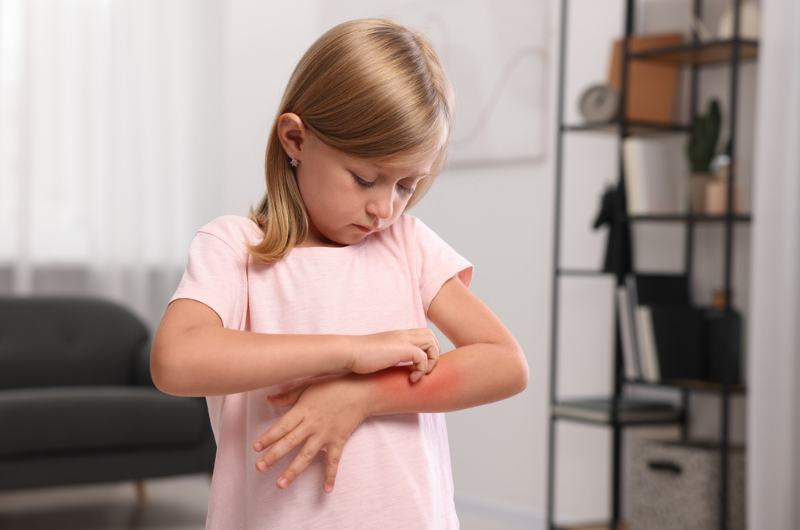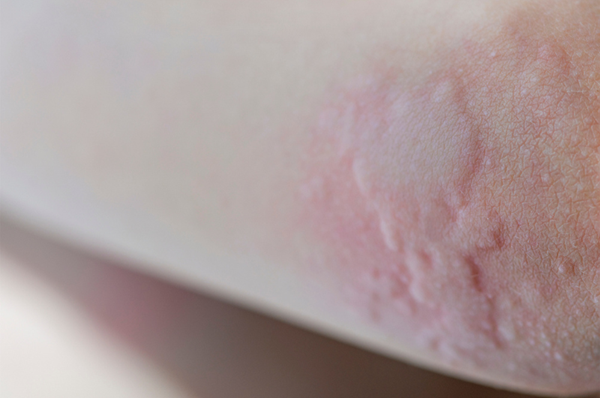Food Allergy Rash: What Does It Look Like?

September 04, 2024
You’re cleaning up from the dinnertime rush when your child approaches you, scratching their arm. You notice a strange rash that wasn’t there before. How do you figure out what it is? Could it be a food allergy rash?
“The most common rash to present with food allergy is hives (urticaria)," explains Tamar Weinberger, M.D., a pediatric allergy and immunology physician. These raised, itchy bumps can appear anywhere on the body.
What Does a Food Allergy Rash Look Like?

A typical food allergy rash, known as hives, presents with:
- Intense itching
- No scarring
- Rapid onset and disappearance (usually within 6 hours)
- Red, raised welts on the skin
It's important to differentiate food allergy rashes from other skin irritations. So other than its appearance, how do you know if the rash came from a food allergy? A rash from food allergies typically occurs between 15 minutes to 2 hours after ingesting a new food. They sometimes show up with other allergy symptoms like swelling, difficulty breathing or an upset stomach.
Common Food Allergy Triggers
While any food can potentially trigger an allergy, certain culprits are more likely to cause reactions.
For children, the most frequent food allergy triggers are:
- Milk
- Eggs
- Peanuts
Adults tend to be more sensitive to:
- Peanuts
- Shellfish
Other common allergens that can affect both children and adults include:
- Wheat
- Soy
- Fish
- Tree nuts
- Sesame
Remember that these are general trends, and individual sensitivities can vary widely.
What To Do If You Spot a Food Allergy Rash
If you discover a mysterious rash on your child’s skin, don’t panic. While unsettling, not all rashes indicate a food allergy, and not all rashes are serious.
“Food allergic reactions typically develop within two hours of exposure, and they usually last anywhere from four to six hours,” says Dr. Weinberger.
If you suspect a food allergy rash, here's what you can do:
- Observe and document: Take note of the rash's appearance, location and any other symptoms your child experiences. Consider taking photos to share with your doctor.
- Focus on symptom relief: For mild discomfort, an oral antihistamine like diphenhydramine or cetirizine can help decrease itchiness. Topical hydrocortisone cream can soothe the affected area as well.
- Food diary: Keeping a detailed food diary can help you identify potential allergens. This information will help your child’s doctor make a correct diagnosis.
- Consult a pediatrician: Schedule an appointment with your child's doctor to find out the underlying cause of the rash.
“It’s important to document the rash and what your child was eating or drinking, then work with your child’s physician to rule out other potential triggers,” Dr. Weinberger emphasizes.
What if Your Child's Food Allergy Rash Isn't Going Away?
If your child's rash persists despite treatment, see a pediatrician or allergist. Several factors could lead to an ongoing issue:
- Incorrect diagnosis: The rash might be caused by a different allergen or skin condition.
- Secondary infection: Sometimes, a skin infection can develop on top of the rash, prolonging symptoms.
Don't hesitate to seek medical advice if:
- The rash spreads or worsens
- Your child develops other symptoms like fever, difficulty breathing or swelling
- The rash doesn't improve after a few days of treatment
In Case of Emergency
While most food allergy rashes are manageable at home, it’s smart to know the signs of a more severe allergic reaction. If your child experiences any of the following symptoms in addition to a rash, seek immediate medical attention. These symptoms may indicate anaphylaxis, a life-threatening allergic reaction:
- Difficulty breathing
- Dizziness or lightheadedness
- Rapid heartbeat
- Swelling of the face, lips or tongue
- Tightness in the throat
“Not all hives progress to anaphylaxis,” says Dr. Weinberger. But if they do, it’s crucial to get your child immediate medical care.
The bottom line: Food allergy rashes can generally be treated with over-the-counter allergy medications. They’re manageable with proper care and attention. By understanding the signs and symptoms, you can take steps to protect your family's health and well-being.
Next Steps & Resources
- Meet our source: Tamar Weinberger, M.D.
- To make an appointment with a doctor near you, call 800-822-8905 or visit our website.
- Learn more about our pediatric allergy and immunology services.
The material provided through HealthU is intended to be used as general information only and should not replace the advice of your physician. Always consult your physician for individual care.






